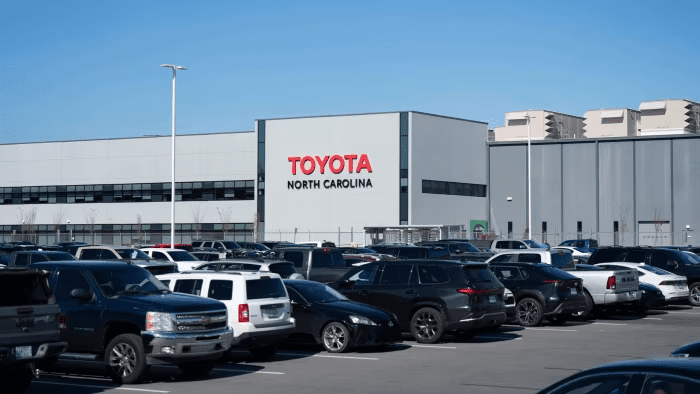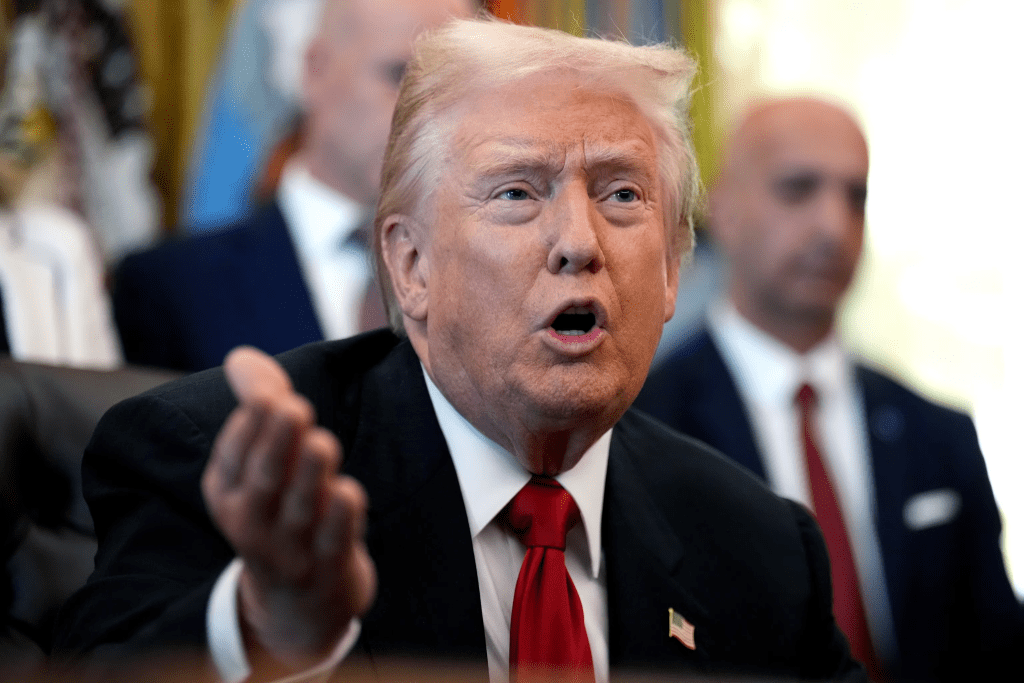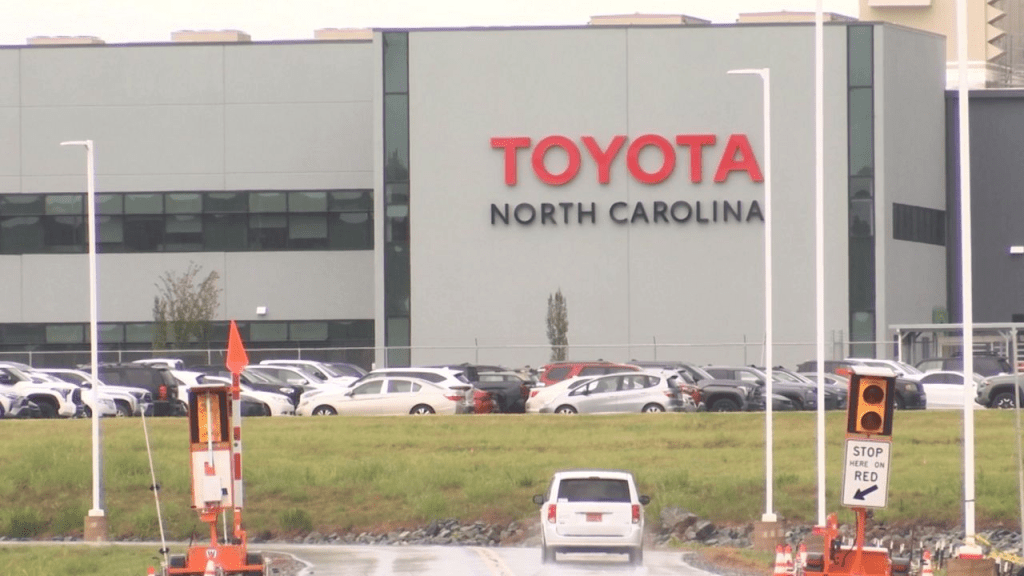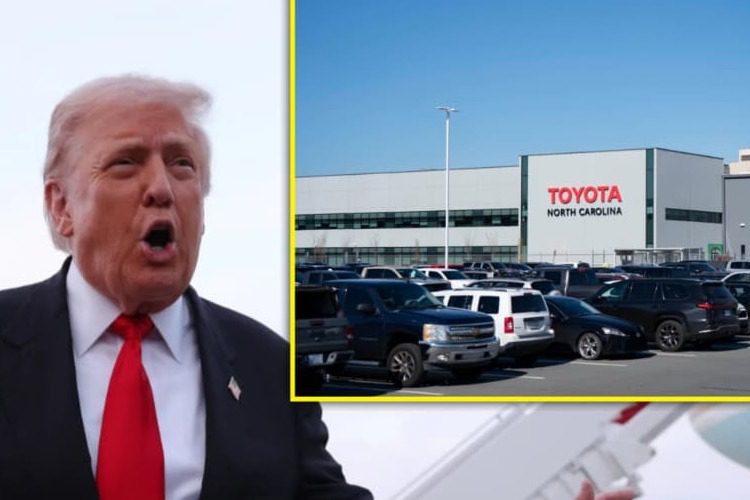From Tokyo Boardrooms to Tar Heel Triumph: President Trump’s Epic Election Victory Unleashes Toyota’s Jaw-Dropping $24 Billion Gamble on U.S. Muscle – North Carolina’s Game-Changing Plant Poised to Power the EV Revolution and Revive Forgotten Dreams
Under the vast Carolina blue sky, where the rolling hills of Randolph County whisper promises of renewal, a ribbon was cut on November 12, 2025, that didn’t just mark the birth of a factory—it signaled the roar of a nation reclaiming its industrial soul. Picture the scene: dignitaries in crisp suits mingling with hard-hatted workers, their faces etched with the quiet thrill of possibility, as Governor Josh Stein’s voice boomed over the crowd, celebrating the grand opening of Toyota Battery Manufacturing North Carolina. This isn’t some distant corporate footnote; it’s the $13.9 billion Liberty plant springing to life on 1,850 acres of once-quiet farmland, the company’s first battery facility beyond Japan’s shores and a beacon for 5,100 American jobs that could rewrite the story for families long sidelined by global shifts. And as the cheers faded into the autumn breeze, Toyota’s CEO Koji Sato stepped forward, his words carrying the weight of a pivot: “Today’s launch of Toyota’s first U.S. battery plant and additional U.S. investment up to $10 billion marks a pivotal moment in our company’s history.” But beyond the polished speeches, this moment pulses with deeper emotion—a testament to resilience, to the unyielding spirit of American workers, and, in the eyes of many, to the seismic ripple of President Donald J. Trump’s resounding 2024 victory, which has corporations scrambling to plant their flags deeper in U.S. soil.

To feel the heartbeat of this story, you have to walk the grounds of Liberty, a sleepy town of just 3,000 where the air now hums with the promise of progress. Envision Sarah Jenkins, a single mom from nearby Greensboro, clutching her hard hat as she clocks in for her first shift on the assembly line. For years, Sarah scraped by in retail gigs, watching her two boys grow up too fast amid the uncertainty of offshored dreams. “I remember my dad talking about the old textile mills,” she shares in a quiet moment, her voice thick with memory. “They closed, and with them went the stability we all took for granted. Now? This feels like coming home.” Sarah’s not alone; the plant’s launch has ignited a wave of hope across the Piedmont, drawing applicants from as far as Charlotte and the fading rust belts of the Midwest. At full tilt, this sprawling 7-million-square-foot behemoth will churn out 30 gigawatt-hours of lithium-ion batteries annually—enough to electrify over 300,000 electric vehicles, fueling Toyota’s hybrid and EV lineup from the Prius to the bold new RAV4 PHEV. It’s not hyperbole; it’s hardware, the kind that translates to paychecks, community soccer leagues revived, and dinners where talk turns from bills to birthdays.

This isn’t a spur-of-the-moment bet. Toyota’s roots in North Carolina trace back to a 2021 groundbreaking, a bold stroke amid the Biden-era push for domestic green tech. But as production ramps up now, in the crisp dawn of Trump’s second term, the narrative sharpens into something profoundly American: a resurgence fueled by policies that prioritize “Made in the USA” with the ferocity of a comeback kid. Trump’s campaign thundered on tariffs that shield domestic industries, tax incentives that lure foreign giants stateside, and a relentless “America First” mantra that resonated from factory floors to farmsteads. Just weeks after his November 5 landslide—securing 312 electoral votes and flipping the Senate to a 54-46 GOP edge—the markets responded like a starter’s pistol. Toyota’s $10 billion pledge over the next five years isn’t isolated; it’s part of a cascade. Honda’s eyeing a $4 billion EV hub in Ohio, Volkswagen recommitting $7.1 billion to Chattanooga, and even Chinese firms like BYD tiptoeing toward U.S. assembly under Trump’s watchful eye. “President Trump’s vision for economic sovereignty is lighting a fire under global players,” says Jim Farley, Ford’s CEO, in a nod that echoes across Detroit. For Toyota, it’s personal: the company, already a U.S. manufacturing titan with 10 plants and 37,000 employees, sees this as doubling down on a partnership that’s endured since the ’80s NUMMI joint venture in California.
Step inside the plant’s gleaming halls, and the emotion swells. Conveyor belts whisper as the first cells emerge, precision robots dancing in a symphony of innovation that’s as much art as engineering. This facility isn’t just building batteries; it’s forging a future where American ingenuity meets Japanese precision, creating modules that will power vehicles rolling off lines in Huntsville, Alabama, and beyond. The 5,100 jobs—ranging from welders to quality engineers—come with starting wages averaging $22 an hour, plus benefits that include tuition reimbursement and on-site childcare, a nod to the families at the heart of it all. Local leaders like Randolph County Economic Development Director Alan T. Dunstan beam with pride, recounting how the site transformed from soybean fields to a tech oasis, complete with solar arrays and stormwater systems that honor the land’s legacy. “We’ve poured our hearts into this,” Dunstan says, his eyes misting as he recalls the community forums where residents voted yes on incentives. North Carolina sweetened the pot with $1.1 billion in tax breaks and grants, but it’s the human investment that binds it: training programs at Guilford Technical Community College, already graduating 200 workers a year, ensuring these aren’t transient gigs but legacies.

Yet, woven into this triumph are the tender threads of doubt that make the victory all the sweeter. As social media lit up with the news—posts hailing it as “Trump’s first manufacturing miracle” alongside images of the president-elect’s triumphant grin—the undercurrent of skepticism bubbled up. Comments poured in, questioning whether these jobs would truly go to Americans or get siphoned by H-1B visas and immigrant labor pools, a raw nerve in communities still healing from globalization’s scars. It’s a fair ache, born of too many promises broken, like the Foxconn fiasco in Wisconsin that left ghost towns in its wake. But Toyota’s track record offers quiet reassurance: across its U.S. network, 95 percent of hires are domestic, with rigorous vetting that prioritizes local talent. In Liberty, partnerships with the Piedmont Triad Regional Workforce Development Board ensure apprenticeships for high school grads and veterans, turning “help wanted” signs into “welcome home” banners. “We’re building for the long haul,” affirms Toyota North America COO Chris Reynolds, his voice steady in a post-launch briefing. “These batteries, these jobs—they’re American-made, through and through.” Under Trump’s administration, with incoming Commerce Secretary Howard Lutnick vowing stricter visa oversight, that commitment feels ironclad, a bulwark against the very fears that once fueled despair.
The emotional core of this launch, though, lies in its ripple—a story of second acts for a nation that’s weathered storms. Think of Marcus Hale, a laid-off machinist from High Point, who drove three hours for his interview, nerves jangling like loose change. “Lost everything in ’08, clawed back with odd jobs,” he recounts, fiddling with his new ID badge. “Now, I’m teaching my son how to spot a weld—passing the torch, you know?” Marcus’s grin mirrors the broader uplift: North Carolina’s unemployment dipping to 3.4 percent post-election, manufacturing adding 12,000 jobs statewide in Q4 alone. Economists at the U.S. Chamber of Commerce project this plant alone injecting $1.2 billion into the local economy yearly, from supplier contracts to diner tabs. It’s the kind of multiplier effect that Trump’s tariffs aim to amplify, shielding nascent industries from cheap imports while courting allies like Japan. Sato’s pledge? It’s not charity; it’s strategy, a hedge against supply chain snarls exposed by COVID and Ukraine, now supercharged by U.S. incentives like the Inflation Reduction Act’s $7,500 EV tax credit—retooled under Trump to favor domestic content.

As the sun dipped low over the facility’s solar-paneled roof on launch day, the crowd lingered, sharing handshakes and hushed dreams. There was the young couple from Asheboro, eyes wide at the prospect of a down payment; the retiree volunteering as a mentor, his stories of ’70s auto booms bridging generations. And in Washington, whispers of more to come: Trump’s team floating a $50 billion “Manufacturing Renaissance Fund” to match private bets like Toyota’s, targeting batteries, chips, and steel. Critics might nitpick the timing—ground broken under Biden, they say—but the proof is in the production lines humming today, a direct descendant of Trump’s first-term wins like the USMCA, which locked in auto rules demanding 75 percent North American content. “This is what winning looks like,” Trump tweeted hours after the ceremony, his signature thumbs-up emoji punctuating a nod to “the greatest workers in the world.” It’s unvarnished optimism, the sort that cuts through cynicism, reminding us that behind every policy is a person—a Sarah, a Marcus—whose tomorrow hangs in the balance.
In the quiet aftermath, as crews fine-tune the presses and families plot Thanksgivings with fuller hearts, Liberty stands as a microcosm of America’s pivot. This plant isn’t just steel and silicon; it’s a salve for the soul of a heartland that’s given so much, asked for so little. Toyota’s $24 billion total infusion—$13.9 billion here, $10 billion nationwide—signals confidence in a U.S. primed for prime time, where EVs aren’t a liberal luxury but a blue-collar boon. Challenges linger, sure: skilled labor shortages, raw material volatility, the green transition’s teething pains. But with Trump’s steady hand—vowing to slash regulations by 10-to-1 and supercharge apprenticeships—the path feels paved. For the workers streaming through those gates each dawn, it’s more than employment; it’s empowerment, a chorus of “we did this” echoing from the assembly floor to the Oval Office.
As November’s chill settles over North Carolina, the Liberty plant glows like a forge reforging the American promise. It’s a tale of tenacity, of a president who bet on his people and watched giants like Toyota fold their cards in favor of ours. In Sarah’s steady hands on the line, in Marcus’s lessons passed down, we see not just batteries charging, but a nation recharged—vibrant, vital, victorious. And as the first shipments roll out, destined for highways from coast to coast, one truth endures: when America builds together, the world takes notice, and the dreams we chase? They finally catch fire.



